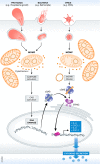Mitochondria and pathogen immunity: from killer to firestarter
- PMID: 31101675
- PMCID: PMC6545555
- DOI: 10.15252/embj.2019102325
Mitochondria and pathogen immunity: from killer to firestarter
Abstract
Serving as an innate defence mechanism, invading pathogens elicit a broad inflammatory response in cells. In this issue, Brokatzky et al (2019) report that pathogens can cause activation of BAX/BAK which permeabilises a limited number of mitochondria. Induction of DNA damage, or release of mtDNA, triggers STING-dependent pro-inflammatory cytokine expression and secretion, revealing an unexpected role for the mitochondrial apoptotic machinery in immune defence.
© 2019 The Authors.
Figures

Comment on
-
A non-death function of the mitochondrial apoptosis apparatus in immunity.EMBO J. 2019 Jun 3;38(11):e100907. doi: 10.15252/embj.2018100907. Epub 2019 Apr 12. EMBO J. 2019. PMID: 30979778 Free PMC article.
References
Publication types
MeSH terms
Substances
LinkOut - more resources
Full Text Sources
Research Materials

